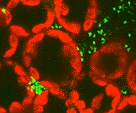Plant Pathology, Department of

Department of Plant Pathology: Faculty Publications
Document Type
Article
Date of this Version
2012
Citation
Plant Diseases Management Reports 6, FC074 (2012).
Abstract
A foliar fungicide efficacy trial was conducted at the University of Nebraska-Lincoln South Central Agricultural Laboratory near Clay Center, NE. DeKalb corn hybrid DKC 62-54, rating of “good” (6 out of 9) for gray leaf spot (GLS) and “excellent” (2 out of 9) for common rust (CR), was planted on 3 May in 30 in. rows with a target population of 32,000 plants/A. The trial area was disked with a crop history of seven years of continuous corn. On 9 May before plant emergence, a herbicide program of Roundup (1 pt/A), Verdict (16 fl oz/A) and Atrazine (1 lb/A) was applied to the trial site. Ten treatments and a nontreated control were replicated six times in a randomized complete block design. Each plot was four rows (10 ft) wide by 40 ft in length. . . . Among all treatments, the nontreated control had the lowest stay green percentage (23.7%) while Stratego YLD, 4 fl oz/A had the highest stay green percentage (29.4%). There were no significant differences among treatments for 500-count kernel weights. There were no statistical differences in grain moisture as moisture percentages at harvest ranged from 14.0% to 14.3%. There were statistical differences between treatments for yield. Quilt, 14 fl oz/A and Stratego YLD, 4 fl oz/A were the highest yielding treatments with 238.7 bu/A and 237.2 bu/A, respectively.


Comments
Copyright © 2012 The American Phytopathological Society. Used by permission.